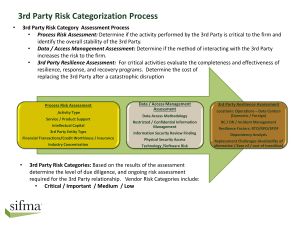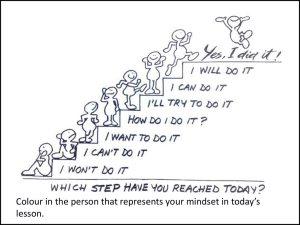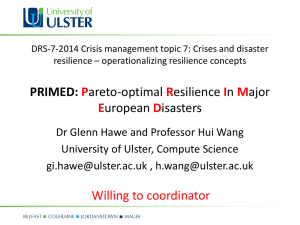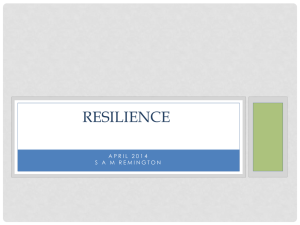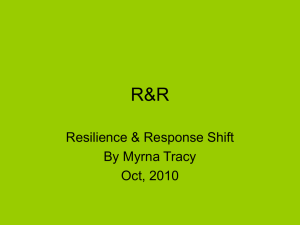Document
advertisement
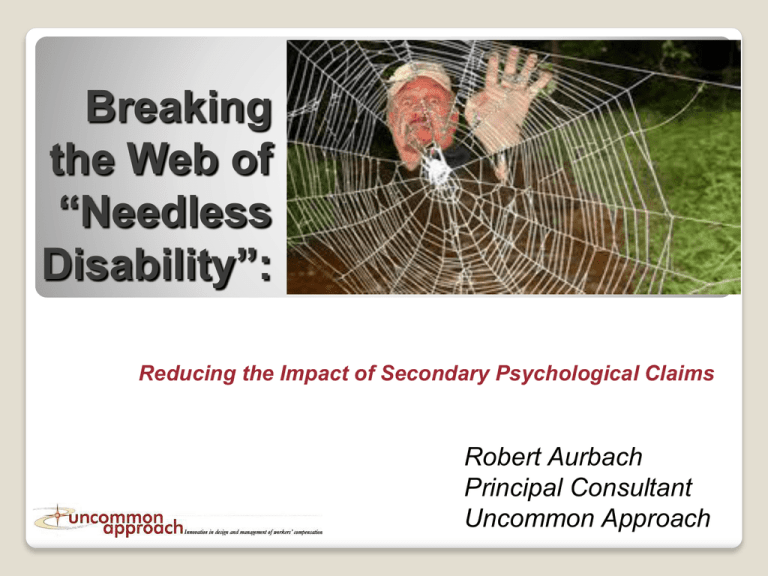
Breaking the Web of “Needless Disability”: Reducing the Impact of Secondary Psychological Claims Robert Aurbach Principal Consultant Uncommon Approach Some people recover as expected…some spiral down into despair and dependency How can you impact the worker’s outcome? What are “secondary psych” claims? Some claimants develop psychological “signs and symptoms” in addition to their original condition ◦ Symptoms are what the worker reports ◦ “Signs” are the objective observations of a trained medical professional and include the results of objective testing ◦ The comparison of “signs” and “symptoms” for consistency is an important part of claims management The secondary condition can be a more serious blocker to return to work than the primary injury. “Secondary Psych” claims are important We are addressing the reason that some people get better and some people do not Corporate perspective: Secondary Psych is a major cost driver underlying most failure to return to work and extended incapacity payments Personal Perspective: The cases where there is an unnecessary failure to recover/resume normal life make up the majority of the 20% of claims that cost about 80% of our time and resources It’s helpful to understand Secondary Psych better… Without a model of what’s happening, all you have is studies that show correlations between various factors and disability. But a model of how this happens helps us to intervene effectively We’ve learned a lot about how the brain works in the last few years…. • • • We learn almost every complex behaviour in the same way It’s been proven with experiments directly on the brain And proven by “miraculous” cures – Stroke and head injuries – Recovery from “phantom” pain The brain has to make sense of a LOT Everything that is coming in at one time is processed together The links between thoughts, emotions, and sensations are links in TIME, not in causation First Law of Neuroplasticity Neurons (brain cells) that fire together, wire together” This is the first law of neuroplasticity (don’t worry… there are only two) The brain cells that are linked together are called a “neural network” Neural Networks Have you ever experienced a song, a scent, or a picture that brought up memories of another time or place? There is a change in the neural connections with repetition Nerves fire faster and more automatically Less “conscious thought” is involved There is less opportunity for examination of the reaction Why “facilitated neural networks” are critically important When things are associated in facilitated neural networks, the stimulation of one part of the network fires all the things that are linked into it thoughts emotions physical sensations (including chronic pain) We learn almost everything this way • • • • • How to speak without thinking about how to form the words Playing music or sports Habits Superstitions How to take the role of a “victim” or a “disabled person” How do we Learn? “Practice Makes Perfect” How much repetition is “enough”? Changes in the brain begin to happen very quickly, and more quickly when attention is focused • “Mental rehearsing” is nearly as effective as physical experience in creating and solidifying the neural network* • This is the operational mechanism behind the research on the impact of delay of return to work (probability of return <50% after 12 weeks lost time) • The mental rehearsing turns out to be the “most important” for understanding disability That’s where the opportunity to affect the outcome is most often present Sometimes we call this mental rehearsal “selftalk” The “Web of Disability” Sleeplessness (fear of sleeplessness) Loss of (work) Identity Psychosocial factors LOSS OF CONTROL ANXIETY Economic Pressure Anger, frustration, worry, catastrophic thinking PAIN (fear of pain) Specific negative messages Environmental messages Copyright 2012, Robert M. Aurbach The “Simple” formula for Disability Negative self-talk > ability to “overcome” the negative messages = loss of control What Loss does it feel like to be out of control? of control is an intolerable state, which requires a person to adopt a new “identity” that is consistent with “regaining control” under the circumstances Our cultural environment often suggests the role of “Disabled Person” to the injured If a new identity as a disabled person is resisted, then the strain of living out of control can be too much That’s where we see the development of secondary psychological injury There are two ways to prevent adoption of the “Disabled” Mentality or Secondary Psychological Injury Reduce the negative inputs (Interventions that influence how the system impacts the worker) Change the nature of the self-talk (Interventions that look to bolstering the workers’ “resilience”) Effectively reducing the negative inputs You CAN have an impact Fix things before they get bad – Early Intervention “Fixing things” should be done quickly Creation of a “Web of Disability” takes repetition Repetition takes time If the thought, emotion or sensation is removed quickly enough, the new “habit of thought” including it doesn’t have time to become entrenched Why Early Intervention Works Reduces loss of work identity Reduces opportunity for specific negative messages Reduces anger, frustration and catastrophic thinking Reduces anxiety and sleeplessness The “Second Law” of Neuroplasticity • The brain is wonderfully efficient and will “recycle” resources that aren’t being used • “Use it or lose it” Put someone back to work, and the habits around staying home get replaced with work routines and thought patterns Why Return to Work is effective Reduces loss of work identity Reduces economic pressure Reduces anxiety and sleeplessness Combination of Early Intervention & RTW Sleeplessness (fear of sleeplessness) Psychosocial factors Loss of (work) Identity LOSS OF CONTROL ANXIETY Economic Pressure Anger, frustration, worry, catastrophic thinking PAIN (fear of pain) Specific negative messages Environmental messages Copyright 2012, Robert M. Aurbach Inadvertent actions in managing the claim can create needless disability NONE of this is an issue of “fault” but most can be reduced or prevented ◦ Delay ◦ Implied messages ◦ Driving the claimant into the hands of lawyers ◦ Failure to set positive expectations ◦ Failure to acknowledge and respond to what they are experiencing What can you do? Be responsive and acknowledge Realise that no matter how many pending files you have, his or her case is the only one that is important to them Understand that your actions have a massive impact on his or her retention or loss of the critical sense of control over his or her own life. There’s a third line of defence Changing the nature of the self-talk Resilience Research on Resilience Data shows that people with high levels of resilience were: ◦ Less likely to have time off following injury ◦ More likely to recover and return to work quickly ◦ More emotionally and physically ready to return to work ◦ Less likely to believe that someone else was responsible for their injury/accident What is “resilience”? The literature has “defined” resilience by its observed effects We “foster” resilience by things like encouraging people to “increase their self esteem” and “promote good relationships“ and “be hopeful” This circular approach hasn’t proven very effective What we call “Resilience” is really the ability to resist negative self-talk How does it work? Repetition is necessary to make the changes in the brain that are associated with disability The repetition comes mostly from self-talk If we can build up the ability to quiet the self-talk, the sense of loss of control doesn’t get stimulated as much by the claims environment If the negative self-talk is quieted, then it’s easier to keep a sense of control If people keep their sense of control, they can “bounce back” better from adversity There appear to be four strategies used (singly or in combination) by resilient people in resisting negative self-talk Drown out the negative messages (“Believer”) Change the negative messages (“Reframer”) Make the mind too busy to attend to negativity (“Achiever”) Create separation of the sense of self from the source of the negativity (“Distancer”) We can tailor the intervention to the existing “resilience” style By working with the injured worker’s strengths, interventions can empower -instead of creating dependency A “better” simple formula: Early Intervention/Return to work + Maximizing inherent resilience = Substantially fewer instances of unexpected failure to recover Questions?? Thank you! Robert Aurbach Rob@uncommonapproach.com 0458891621



